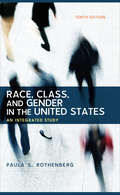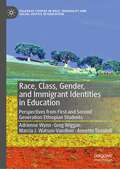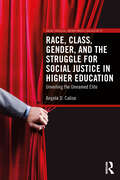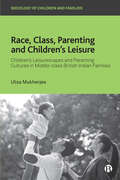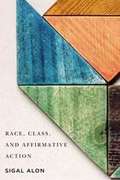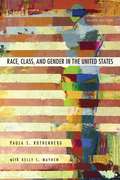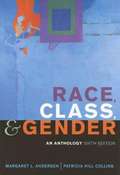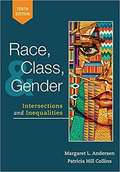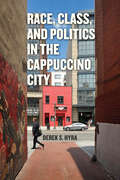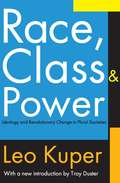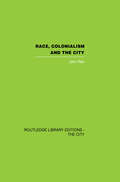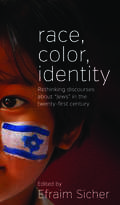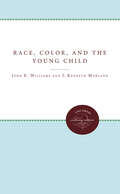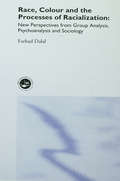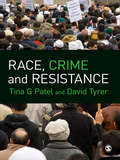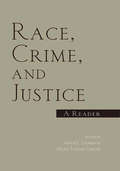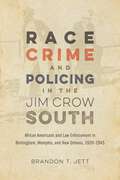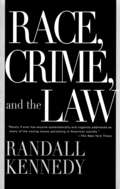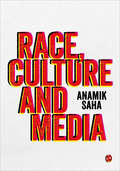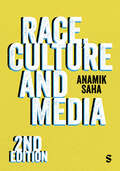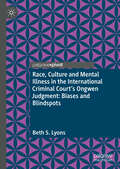- Table View
- List View
Race, Class, And Gender In The United States 10th Edition
by Paula S. Rothenberg Soniya MunshiThis best-selling anthology expertly explores concepts of identity, diversity and inequality as it introduces students to race, class, gender, and sexuality in the United States. The thoroughly updated 10th edition features 38 new readings. New material explores citizenship and immigration, mass incarceration, sex crimes on campus, transgender identity, the school to prison pipeline, food insecurity, the Black Lives Matter movement, the pathology of poverty, socioeconomic privilege vs. racial privilege, pollution on tribal lands, stereotype threat, gentrification and more. The combination of thoughtfully selected readings, deftly written introductions, and careful organization make Race, Class, and Gender, 10th edition the most engaging and balanced presentation of these issues available today.
Race, Class, Gender, and Immigrant Identities in Education: Perspectives from First and Second Generation Ethiopian Students (Palgrave Studies in Race, Inequality and Social Justice in Education)
by Greg Wiggan Marcia J. Watson-Vandiver Adrienne Wynn Annette TeasdellThis volume addresses the underlying intersections of race, class, and gender on immigrant girls’ experiences living in the US. It examines the impact of acculturation and assimilation on Ethiopian girls’ academic achievement, self-identity, and perception of beauty. The authors employ Critical Race Theory, Critical Race Feminism, and Afrocentricity to situate the study and unpack the narratives shared by these newcomers as they navigate social contexts rife with racism, xenophobia, and other forms of oppression. Lastly, the authors examine the implications of Ethiopian immigrant identities and experiences within multicultural education, policy development, and society.
Race, Class, Gender, and the Struggle for Social Justice in Higher Education: Unveiling the Unnamed Elite (New Critical Viewpoints on Society)
by Angela D. CaliseOffering readers an insightful exploration of the challenges faced by leaders in higher education as they navigate the complexities of promoting social justice and caring for minoritized populations, this book delves into their untold stories to reveal the triumphs and struggles of these influential individuals.By unveiling the undercurrents of higher education and the hidden dynamics at play, Race, Class, Gender, and the Struggle for Social Justice in Higher Education details the battle for social justice and the experiences of leadership elites, serving as an invaluable resource for anyone passionate about the intersection of leadership, social justice, and the imperative to create inclusive environments in higher education, shedding light on leaders’ motivations, behaviors, and barriers in advancing social justice on college campuses.This book will be relevant to instructors and students in higher education, leadership, and sociology courses, offering insights into the challenges faced by leadership elites in promoting social justice and supporting marginalized populations.
Race, Class, Parenting and Children’s Leisure: Children’s Leisurescapes and Parenting Cultures in Middle-class British Indian Families (Sociology of Children and Families)
by Utsa MukherjeeChildren’s leisure lives are changing, with increasing dominance of organised activities and screen-based leisure. These shifts have reconfigured parenting practices, too. However, our current understandings of these processes are race-blind and based mostly on the experiences of white middle-class families. Drawing on an innovative study of middle-class British Indian families, this book brings children’s and parents’ voices to the forefront and bridges childhood studies, family studies and leisure studies to theorise children’s leisure from a fresh perspective. Demonstrating the salience of both race and class in shaping leisure cultures within middle-class racialised families, this is an invaluable contribution to key sociological debates around leisure, childhoods and parenting ideologies.
Race, Class, and Affirmative Action
by Sigal AlonNo issue in American higher education is more contentious than that of race-based affirmative action. In light of the ongoing debate around the topic and recent Supreme Court rulings, affirmative action policy may be facing further changes. As an alternative to race-based affirmative action, some analysts suggest affirmative action policies based on class. In Race, Class, and Affirmative Action, sociologist Sigal Alon studies the race-based affirmative action policies in the United States. and the class-based affirmative action policies in Israel. Alon evaluates how these different policies foster campus diversity and socioeconomic mobility by comparing the Israeli policy with a simulated model of race-based affirmative action and the U.S. policy with a simulated model of class-based affirmative action. Alon finds that affirmative action at elite institutions in both countries is a key vehicle of mobility for disenfranchised students, whether they are racial and ethnic minorities or socioeconomically disadvantaged. Affirmative action improves their academic success and graduation rates and leads to better labor market outcomes. The beneficiaries of affirmative action in both countries thrive at elite colleges and in selective fields of study. As Alon demonstrates, they would not be better off attending less selective colleges instead. Alon finds that Israel’s class-based affirmative action programs have provided much-needed entry slots at the elite universities to students from the geographic periphery, from high-poverty high schools, and from poor families. However, this approach has not generated as much ethnic diversity as a race-based policy would. By contrast, affirmative action policies in the United States have fostered racial and ethnic diversity at a level that cannot be matched with class-based policies. Yet, class-based policies would do a better job at boosting the socioeconomic diversity at these bastions of privilege. The findings from both countries suggest that neither race-based nor class-based models by themselves can generate broad diversity. According to Alon, the best route for promoting both racial and socioeconomic diversity is to embed the consideration of race within class-based affirmative action. Such a hybrid model would maximize the mobility benefits for both socioeconomically disadvantaged and minority students. Race, Class, and Affirmative Action moves past political talking points to offer an innovative, evidence-based perspective on the merits and feasibility of different designs of affirmative action.
Race, Class, and Gender in the United States: An Integrated Study
by Paula S. RothenbergThis book presents an integrated study into a better world, a community that identifies, tackles and solves its problems effectively. Thinking about the community and its characteristics, it focuses on race, gender and sexuality from a social context. As much as the titles sound like happenings of the past, way back from our forefathers of our forefathers, its what makes up and differentiates communities from each other. Surprisingly, every community has norms and behaviors, beliefs and gender roles that govern them yet to others may be held as discrimination against the specified gender. Race, Class, And Gender In The United States,inclusively takes an in-depth study in racism, sexism, heterosexism, and class, and Complicating Questions of Identity: Race, Ethnicity and Immigration.
Race, Class, and Gender: An Anthology
by Patricia Hill Collins Margaret L. AndersenEach reading addresses a timely-and often controversial-topic, such as health care inequality, undocumented students, domestic violence, genetic technologies, and the effect of the media on body image, thereby giving readers a multidimensional perspective on a number of social issues.
Race, Class, and Gender: An Anthology (6th edition)
by Patricia Hill Collins Margaret L. AndersenThis anthology introduces students to how race, class, and gender shape the experiences of diverse groups in the U.S. Introductory essays for each of the four sections stress the interconnectedness of these various types of difference. Each section concludes with some suggestions for further reading. The sixth edition contains 19 new readings dealing with such issues as affirmative action, immigration, and military rank.
Race, Class, and Gender: Intersections and Inequalities
by Patricia Hill Collins Margaret L. AndersenTimely, relevant and extremely student-friendly, Andersen/Hill Collins' RACE, CLASS, AND GENDER: INTERSECTIONS AND INEQUALITIES, 10th edition, equips you with a multidimensional perspective on today's social issues. Written by two leading authorities in the field, this classic anthology uses a diverse collection of writings by a variety of scholars to demonstrate how the complex intersection of people's race, class, gender and sexuality shapes their experiences in U.S. society. Professors Andersen and Hill Collins begin each section with in-depth introductions to provide an analytical framework for understanding social inequality. Completely up-to-date, the readings cover current--and often controversial topics--including undocumented students, myths about immigrant crime, growing inequality, the role of social media in social movement mobilization, health care inequality and more.
Race, Class, and Politics in the Cappuccino City
by Derek S. HyraFor long-time residents of Washington, DC’s Shaw/U Street, the neighborhood has become almost unrecognizable in recent years. Where the city’s most infamous open-air drug market once stood, a farmers’ market now sells grass-fed beef and homemade duck egg ravioli. On the corner where AM.PM carryout used to dish out soul food, a new establishment markets its $28 foie gras burger. Shaw is experiencing a dramatic transformation, from “ghetto” to “gilded ghetto,” where white newcomers are rehabbing homes, developing dog parks, and paving the way for a third wave coffee shop on nearly every block. Race, Class, and Politics in the Cappuccino City is an in-depth ethnography of this gilded ghetto. Derek S. Hyra captures here a quickly gentrifying space in which long-time black residents are joined, and variously displaced, by an influx of young, white, relatively wealthy, and/or gay professionals who, in part as a result of global economic forces and the recent development of central business districts, have returned to the cities earlier generations fled decades ago. As a result, America is witnessing the emergence of what Hyra calls “cappuccino cities.” A cappuccino has essentially the same ingredients as a cup of coffee with milk, but is considered upscale, and is double the price. In Hyra’s cappuccino city, the black inner-city neighborhood undergoes enormous transformations and becomes racially “lighter” and more expensive by the year.
Race, Class, and Power: Ideology and Revolutionary Change in Plural Societies
by Leo KuperExamining in detail the apparently inexorable polarization of society in such countries as Rwanda, Algeria, and South Africa, the author questions whether current theories correctly explain the past or offer adequate guides for the future. In their place he puts forward an alternative neo-Durkheimian view of the possibility of non-violent revolutionary change, based on the development of such social and cultural continuities as already exist within each plural society. But he warns that -this is an age of passionate commitment to violence in which vicarious killers abound in search of a Vietnam of their own.- The aim of this groundbreaking and challenging book is to create theoretical perspectives in which to view the racial conflict of plural societies. Written in the turbulent early 1970s, the book demonstrates the inadequacy of then prevailing views such as Marxist interpretations of racial conflict as class struggle, and the Fanon a priori rejection of non-violent techniques of change, which Kuper holds responsible for the acceptance of what he calls -the platitudes of violence.- The book concludes with more personal sections focusing on the author's struggles with the then prevailing South African society, critiques of that, and censorship of his attempts to make these public. In the light of subsequent changes in South Africa many decades later, this book serves not only as an important work of political sociology but as a personal testament to the fight against racism in South Africa. Leo Kuper was professor of sociology and director of the African Studies Center at the University of California, Los Angeles. A South African by birth, he was one of the first writers on genocide as well as other aspects of African studies and urban sociology. His major book, Genocide (Penguin, 1981), remains in print. The Leo Kuper Foundation is a non-governmental organization dedicated to the eradication of genocide through research, advice, and education. It was created in Washington, DC in 1994 following the death of Leo Kuper, with the aim of improving measures to prevent genocide. The main area of work for the past five years has been in support of the creation of an International Criminal Court. Troy Duster is director at the Institute for the History of the Production of Knowledge, New York University.
Race, Colonialism and the City
by John RexJohn Rex is well known as one of Britain's leading sociologists and for his special interest in the sociology of race relations and the sociology of the city. In the present book these two related areas are brought together. Professor Rex discusses imperialistic social systems, and examines the position of black people at the colonial and metropolitan ends of thoses systems. This book was first published in 1973.
Race, Color, Identity
by Efraim SicherAdvances in genetics are renewing controversies over inherited characteristics, and the discourse around science and technological innovations has taken on racial overtones, such as attributing inherited physiological traits to certain ethnic groups or using DNA testing to determine biological links with ethnic ancestry. This book contributes to the discussion by opening up previously locked concepts of the relation between the terms color, race, and "Jews", and by engaging with globalism, multiculturalism, hybridity, and diaspora. The contributors-leading scholars in anthropology, sociology, history, literature, and cultural studies-discuss how it is not merely a question of whether Jews are acknowledged to be interracial, but how to address academic and social discourses that continue to place Jews and others in a race/color category.
Race, Color, and the Young Child
by John Williams J. Kenneth MorlandA social-developmental psychologist and a social anthropologist describe what is known--and what needs to be investigated--concerning the development of race and color concepts in young children. The authors summarize the results of their fifteen-year research and integrate their findings with those of other investigators to provide, in a single source, a much-needed summary of the research literature and a more comprehensive theoretical analysis than has appeared previously.Originally published in 1976.A UNC Press Enduring Edition -- UNC Press Enduring Editions use the latest in digital technology to make available again books from our distinguished backlist that were previously out of print. These editions are published unaltered from the original, and are presented in affordable paperback formats, bringing readers both historical and cultural value.
Race, Colour and the Processes of Racialization: New Perspectives from Group Analysis, Psychoanalysis and Sociology
by Farhad DalalIs racial conflict determined by biology or society?So many conflicts appear to be caused by racial and ethnic differences; for example, the cities of Britain and America are regularly affected by race riots. It is argued by socio-biologists and some schools of psychoanalysis that our instincts are programmed to hate those different to us by evolutionary and developmental mechanisms. This book argues against this line, proposing an alternative drawing on insights from diverse disciplines including anthropology, social psychology and linguistics, to give power-relations a critical explanatory role in the generation of hatreds. Farhad Dalal argues that people differentiate between races in order to make a distinction between the 'haves' and 'must-not-haves', and that this process is cognitive, emotional and political rather than biological. Examining the subject over the past thousand years, Race, Colour and the Processes of Racialisation covers:* psychoanalytic and other theories of racism* a new theorisation of racism based on group analytic theory* a general theory of difference based on the works of Fanon, Elias, Matte-Blanco and Foulkes* application of this theory to race and racism.Farhad Dalal concludes that the structures of society are reflected in the structures of the psyche, and both of these are colour coded. This book will be invaluable to students, academics and practitioners in the areas of psychoanalysis, group analysis, psychotherapy and counselling.
Race, Crime and Resistance
by David Tyrer Tina PatelIn a post-Macpherson, post-9/11 world, criminal justice agencies are adapting their responses to criminal behaviour across diverse ethnic groups. Race, Crime and Resistance draws on contemporary theory and a range of case studies to consider racial inequalities within the criminal justice system and related organisations. Exploring the mechanisms of discrimination and exclusion, the book goes beyond superficial assumptions to examine the ensuing processes of mobilisation and resistance across disadvantaged groups. Empirically grounded and theoretically informed, the book critically unpicks the persisting concepts of race and ethnicity in the perceptions and representations of crime. Articulate and sensitive, the book clarifies complex ideas through the use of chapter summaries, case studies, further reading and study questions. It is essential reading for students and scholars of criminology, race and ethnicity, and sociology.
Race, Crime, and Justice: A Reader
by Shaun L. Gabbidon Helen Taylor GreeneA comprehensive collection of the essential writings on race and crime, this important Reader spans more than a century and clearly demonstrates the long-standing difficulties minorities have faced with the justice system. The editors skillfully draw on the classic work of such thinkers as W.E.B. DuBois and Gunnar Myrdal as well as the contemporary work of scholars such as Angela Davis, Joan Petersilia, John Hagen and Robert Sampson. This anthology also covers all of the major topics and issues from policing, courts, drugs and urban violence to inequality, racial profiling and capital punishment. This is required reading for courses in criminology and criminal justice, legal studies, sociology, social work and race.
Race, Crime, and Justice: The Continuing American Dilemma (Keynotes in Criminology and Criminal Justice)
by Steven E. BarkanBrief, timely, and accessible, Race, Crime, and Justice: The Continuing American Dilemma examines many critical issues including why, over the past few decades, African Americans, Latinos, and Native Americans were swept into jails and prisons at rates far beyond their share of the national population. Steven E. Barkan explores racial/ethnic disparities in criminal justice involvement; discrimination in policing, prosecution, and sentencing; the rise and collateral consequences of mass incarceration; racial bias in news media coverage of crime; racial/ethnic differences in rates of criminal behavior and victimization; and social and criminal justice policies that, if successfully implemented, would help correct many of the injustices in the criminal justice system. About the Series Keynotes in Criminology and Criminal Justice provides essential knowledge on important contemporary matters of crime, law, and justice to a broad audience of readers. Volumes are written by leading scholars in that area. Concise, accessible, and affordable, these texts are designed to serve either as primers around which courses can be built or as supplemental books for a variety of courses.
Race, Crime, and Policing in the Jim Crow South: African Americans and Law Enforcement in Birmingham, Memphis, and New Orleans, 1920–1945 (Making the Modern South)
by Brandon T. JettThroughout the Jim Crow era, southern police departments played a vital role in the maintenance of white supremacy. Police targeted African Americans through an array of actions, including violent interactions, unjust arrests, and the enforcement of segregation laws and customs. Scholars have devoted much attention to law enforcement’s use of aggression and brutality as a means of maintaining African American subordination. While these interpretations are vital to the broader understanding of police and minority relations, Black citizens have often come off as powerless in their encounters with law enforcement. Brandon T. Jett’s Race, Crime, and Policing in the Jim Crow South, by contrast, reveals previously unrecognized efforts by African Americans to use, manage, and exploit policing. In the process, Jett exposes a much more complex relationship, suggesting that while violence or the threat of violence shaped police and minority relations, it did not define all interactions. Black residents of southern cities repeatedly complained about violent policing strategies and law enforcement’s seeming lack of interest in crimes committed against African Americans. These criticisms notwithstanding, Blacks also voiced a desire for the police to become more involved in their communities to reduce the seemingly intractable problem of crime, much of which resulted from racial discrimination and other structural factors related to Jim Crow. Although the actions of the police were problematic, African Americans nonetheless believed that law enforcement could play a role in reducing crime in their communities. During the first half of the twentieth century, Black citizens repeatedly demanded better policing and engaged in behaviors designed to extract services from law enforcement officers in Black neighborhoods as part of a broader strategy to make their communities safer. By examining the myriad ways in which African Americans influenced the police to serve the interests of the Black community, Jett adds a new layer to our understanding of race relations in the urban South in the Jim Crow era and contributes to current debates around the relationship between the police and minorities in the United States.
Race, Crime, and the Law
by Randall KennedyIn this powerfully reasoned, lucidly written work, Harvard Law Professor Randall Kennedy takes on the highly complex issues of race, crime, and the legal system, uncovering the long-standing failure of the justice system to protect blacks from criminals and revealing difficult truths about these factors in the United States.From the Hardcover edition.
Race, Culture and Media
by Anamik SahaHow do media ‘make’ race? How do legacies of empire shape our understandings of race and media? How does racism structure the media industries? Is the internet an inherently white space? Understanding the relationship between race, culture and media has never been more important. From the demonisation of Muslims to rampant new forms of racism on digital platforms, media are central to understanding how race is both constructed and experienced in everyday life. Yet media are key to resisting racism, too. While they can silence and stereotype us, they can also enable us to cut across difference, to contest and mobilise, and to create genuine community. Race, Culture and Media is a critical, impassioned and accessible exploration of this complex relationship. Anamik Saha outlines the theories, concepts and research you need to know in order to make sense of race, culture and media today - challenging you to move beyond simplistic notions of ‘diversity’ to really engage with issues of both power and participation. It is essential reading for students and researchers across media, communication and cultural studies. Dr Anamik Saha is Senior Lecturer in Media and Communications at Goldsmiths, University of London, where he convenes the MA Race, Media and Social Justice.
Race, Culture and Media
by Anamik SahaHow do media ‘make’ race? How do legacies of empire shape our understandings of race and media? How does racism structure the media industries? Is the internet an inherently white space? Understanding the relationship between race, culture and media has never been more important. From the demonisation of Muslims to rampant new forms of racism on digital platforms, media are central to understanding how race is both constructed and experienced in everyday life. Yet media are key to resisting racism, too. While they can silence and stereotype us, they can also enable us to cut across difference, to contest and mobilise, and to create genuine community. Race, Culture and Media is a critical, impassioned and accessible exploration of this complex relationship. Anamik Saha outlines the theories, concepts and research you need to know in order to make sense of race, culture and media today - challenging you to move beyond simplistic notions of ‘diversity’ to really engage with issues of both power and participation. It is essential reading for students and researchers across media, communication and cultural studies. Dr Anamik Saha is Senior Lecturer in Media and Communications at Goldsmiths, University of London, where he convenes the MA Race, Media and Social Justice.
Race, Culture and Media
by Anamik SahaRace, Culture and Media is a critical, impassioned and accessible exploration of this complex relationship. This new edition moves past conventional discourse on diversity, challenging you to confront the real issues of power and participation. Anamik Saha′s approachable writing starts from the ground up, leading you through nuanced topics such as how capitalism and legacies of colonialism shape media content today, and the value and limitations of key concepts like stereotype, representation and racialisation. You will be empowered to: Understand the multifaceted theories and experiences of race and its intersections with gender, sexuality and class; Analyse key topics, from how algorithms/AI produce racism in digital media, to the politics of superdiversity in popular culture, to ongoing anti-migrant and anti-Muslim racism in news media; Engage with brand new case studies which cover the latest developments on how race is made in media, including YouTube and social media. This book will challenge your preconceptions and ignite your critical thinking, making it essential reading for students and researchers across media, communication and cultural studies.
Race, Culture and Media
by Anamik SahaRace, Culture and Media is a critical, impassioned and accessible exploration of this complex relationship. This new edition moves past conventional discourse on diversity, challenging you to confront the real issues of power and participation. Anamik Saha′s approachable writing starts from the ground up, leading you through nuanced topics such as how capitalism and legacies of colonialism shape media content today, and the value and limitations of key concepts like stereotype, representation and racialisation. You will be empowered to: Understand the multifaceted theories and experiences of race and its intersections with gender, sexuality and class; Analyse key topics, from how algorithms/AI produce racism in digital media, to the politics of superdiversity in popular culture, to ongoing anti-migrant and anti-Muslim racism in news media; Engage with brand new case studies which cover the latest developments on how race is made in media, including YouTube and social media. This book will challenge your preconceptions and ignite your critical thinking, making it essential reading for students and researchers across media, communication and cultural studies.
Race, Culture and Mental Illness in the International Criminal Court’s Ongwen Judgment: Biases and Blindspots
by Beth S. LyonsDominic Ongwen was abducted in 1987 when he was 8 or 9 years old by the Lord’s Resistance Army (‘LRA’) in Northern Uganda and trafficked as a child soldier; he made multiple unsuccessful attempts to escape, and finally succeeded in late 2014. He turned himself into the International Criminal Court in 2015 and was prosecuted. Mr. Ongwen’s defence was that he was not responsible for the crimes of the LRA, based on his mental illnesses and duress, stemming from his abduction and subsequent coercion and indoctrination under Joseph Kony within the LRA. In February 2021, the ICC’s Trial Chamber IX convicted Dominic Ongwen of 61 charges and two modes of liability and he was sentenced to 25 years incarceration. This work critiques the judicial racial and cultural biases and blindspots in the Ongwen Judgment rendered by the ICC, as related to the affirmative defences of mental disease or defect and duress and to sentencing, from the perspective of the author who served as a defence counsel in the case.
